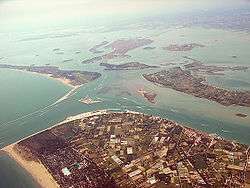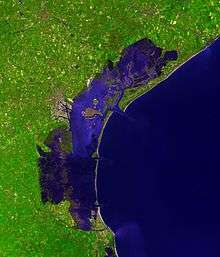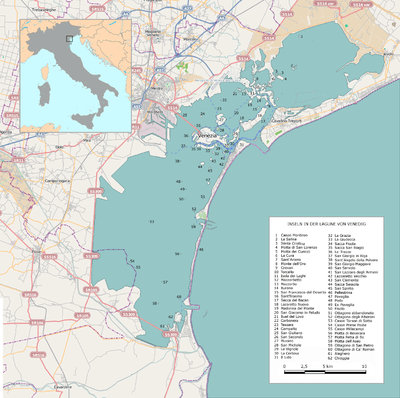Venetian Lagoon
| Venetian Lagoon | |
|---|---|
 Aerial view of the Venetian Lagoon, showing many of the islands including Venice itself, center rear, with the bridge to the mainland | |
| Location | Venice, Veneto, Italy |
| Coordinates | 45°24′47″N 12°17′50″E / 45.41306°N 12.29722°ECoordinates: 45°24′47″N 12°17′50″E / 45.41306°N 12.29722°E |
| Primary outflows | Adriatic Sea |
| Basin countries | Italy |
| Surface area | 550 square kilometres (210 sq mi) |
| Average depth | 10.5 metres (34 ft) |
| Max. depth | 21.5 metres (71 ft) |
| Surface elevation | 3 m (9.8 ft) |
| Settlements | Venice, Campagna Lupia, Cavallino-Treporti, Chioggia, Codevigo, Jesolo, Mira, Musile di Piave, Quarto d'Altino, San Donà di Piave |
The Venetian Lagoon is an enclosed bay of the Adriatic Sea, in northern Italy, in which the city of Venice is situated. Its name in the Italian and Venetian languages, Laguna Veneta—cognate of Latin lacus, "lake"—has provided the international name for an enclosed, shallow embayment of salt water, a lagoon.
Location


The Venetian Lagoon stretches from the River Sile in the north to the Brenta in the south, with a surface area of around 550 square kilometres (212 square miles). It is around 8% land, including Venice itself and many smaller islands. About 11% is permanently covered by open water, or canal, as the network of dredged channels are called, while around 80% consists of mud flats, tidal shallows and salt marshes. The lagoon is the largest wetland in the Mediterranean Basin.[1]
It is connected to the Adriatic Sea by three inlets: Lido, Malamocco and Chioggia. Sited at the end of a largely enclosed sea, the lagoon is subject to high variations in water level, the most extreme being the spring tides known as the acqua alta (Italian for "high water"), which regularly flood much of Venice.
The nearby Marano-Grado Lagoon, with a surface area of around 160 square kilometres (62 square miles), is the northernmost lagoon in the Adriatic Sea and is called sometimes the "twin sister of the Venice lagoon".
Development
The Lagoon of Venice is the most important survivor of a system of estuarine lagoons that in Roman times extended from Ravenna north to Trieste. In the sixth century, the Lagoon gave security to Romanised people fleeing invaders (mostly the Huns). Later, it provided naturally protected conditions for the growth of the Venetian Republic and its maritime empire. It still provides a base for a seaport, the Venetian Arsenal, and for fishing, as well as a limited amount of hunting and the newer industry of fish farming.
The Lagoon was formed about six to seven thousand years ago, when the marine transgression following the Ice Age flooded the upper Adriatic coastal plain.[lower-alpha 1] Deposition of river sediments compensated for the sinking coastal plain, and coastwise drift from the mouth of the Po tended to close tidal inlets with sand bars.
The present aspect of the Lagoon is due to human intervention. In the fifteenth and sixteenth centuries, Venetian hydraulic projects to prevent the lagoon from turning into a marsh reversed the natural evolution of the Lagoon. Pumping of aquifers since the nineteenth century has increased subsidence. Originally many of the Lagoon’s islands were marshy, but a gradual programme of drainage rendered them habitable. Many of the smaller islands are entirely artificial, while some areas around the seaport of the Mestre are also reclaimed islands. The remaining islands are essentially dunes, including those of the coastal strip (Lido, Pellestrina and Treporti).
Venice Lagoon was inhabited from the most ancient times, but it was only during and after the fall of the Western Roman Empire that many people, coming from the Venetian mainland, settled in a number large enough to found the city of Venice. Today, the main cities inside the lagoon are Venice (at the centre of it) and Chioggia (at the southern inlet); Lido di Venezia and Pellestrina are inhabited as well, but they are part of Venice. However, the most part of the inhabitants of Venice, as well as its economic core, its airport and its harbor, stand on the western border of the lagoon, around the former towns of Mestre and Marghera. At the northern end of the lagoon, there is the town of Jesolo, a famous sea resort; and the town of Cavallino-Treporti.
Ecosystem
Occasionally, Bottlenose Dolphins enter the lagoon, possibly for feeding.[3]
The level of pollution in the lagoon has long been a concern.[4][5] The large phytoplankton and macroalgae blooms of the late 1980s were particularly devastating.[6][7] Recently the lagoon has also been identified as being one of the primary areas where non-indigenous species are introduced into the Mediterranean Sea.[8][9]
Islands
The Venice Lagoon is mostly included in the Metropolitan City of Venice, but the south-western area is part of the Province of Padua.

The largest islands or archipelagos by area, excluding coastal reclaimed land and the coastal barrier beaches:
- Venice 5.17 km2
- Sant'Erasmo 3.26 km2
- Murano 1.17 km2
- Chioggia 0.67 km2
- Giudecca 0.59 km2
- Mazzorbo 0.52 km2
- Torcello 0.44 km2
- Sant'Elena 0.34 km2
- La Certosa 0.24 km2
- Burano 0.21 km2
- Tronchetto 0.18 km2
- Sacca Fisola 0.18 km2
- San Michele 0.16 km2
- Sacca Sessola 0.16 km2
- Santa Cristina 0.13 km2
Other inhabited islands include:
- Cavallino
- Lazzaretto Nuovo
- Lazzaretto Vecchio
- Lido
- Pellestrina
- Poveglia
- San Clemente
- San Francesco del Deserto
- San Giorgio in Alga
- San Giorgio Maggiore
- San Lazzaro degli Armeni
- Santa Maria della Grazia
- San Pietro di Castello
- San Servolo
- Santo Spirito
- Sottomarina
- Vignole
See also
Notes
- ↑ This geological history follows Brambati et al. (2003).[2]
References
- ↑ Poggioli, Sylvia (7 January 2008). "MOSE Project Aims to Part Venice Floods". Morning Edition (Radio program). NPR.
- ↑ Brambati, Antonio; Carbognin, Laura; Quaia, Tullio; Teatini, Pietro & Tosi, Luigi (2003). "The Lagoon of Venice: Geological Setting, Evolution and Land Subsidence" (PDF). Episodes. 26 (3): 264–268.
- ↑ Ferretti, Sabrina; Bearzi, Giovanni. "Rare Report of a Bottlenose Dolphin Foraging in the Venice Lagoon, Italy" (PDF). Tethys Research Institute. Archived (PDF) from the original on 2 April 2015.
- ↑ Grancini, Gianfranco & Cescon, Bruno (1971). "Observations of Dispersal Processes of Pollutants in Venice Lagoon and in the Po River Coastal Area". Liège Colloquium on Ocean Hydrodynamics. Société Royale des Sciences de Liège. 2: 99–110.
- ↑ In general, see Lasserre, Pierre; Marzollo, Angelo, eds. (2000). The Venice Lagoon Ecosystem: Inputs and Interactions Between Land and Sea. Man and the Biosphere Series. vol. 25. Paris: Parthenon. ISBN 978-92-3-103595-1.
- ↑ Sfriso, A.; Pavoni, B.; Marcomini, A. & Orio, A. A. (1992). "Macroalgae, Nutrient Cycles, and Pollutants in the Lagoon of Venice". Estuaries. 15 (4): 517–528. doi:10.2307/1352394. JSTOR 1352394.
- ↑ Pranovi, Fabio; Da Ponte, Filippo & Torricelli, Patrizia (2007). "Application of Biotic Indices and Relationship with Structural and Functional Features of Macrobenthic Community in the Lagoon of Venice: An Example over a Long Time Series of Data" (PDF). Marine Pollution Bulletin. 54 (10): 1607–1618. doi:10.1016/j.marpolbul.2007.06.010. Archived (PDF) from the original on 25 December 2015.
- ↑ Occhipinti-Ambrogi, Anna & Savini, Dario (2003). "Biological Invasions as a Component of Global Change in Stressed Marine Ecosystems" (PDF). Marine Pollution Bulletin. 46 (5): 542–551. doi:10.1016/S0025-326X(02)00363-6.
- ↑ Marchini, Agnese; Ferrario, Jasmine; Sfriso, Adriano & Occhipinti-Ambrogi, Anna (2015). "Current Status and Trends of Biological Invasions in the Lagoon of Venice, a Hotspot of Marine NIS Introductions in the Mediterranean Sea". Biological Invasions. 17 (10): 2943–2962. doi:10.1007/s10530-015-0922-3.
Further reading
- Brown, Horatio (1884). Life on the Lagoons. Additional editions printed in 1900, 1904, & 1909; paperback in 2008.
External links
| Wikimedia Commons has media related to Venetian Lagoon. |
- Atlas of the Lagoon - 103 thematic maps and associated explanations grouped in five sections: Geosphere, Biosphere, Anthroposphere, Protected Environments and Integrated Analysis
- SIL – Sistema Informativo della Laguna di Venezia
- Lagoon of Venice information
- Satellite image from Google Maps
- MILVa – Interactive Map of Venice Lagoon
- Comune di Venezia, Servizio Mobilità Acquea, Thematic cartography of Venice Lagoon
- Photo gallery by Enrico Martino about Venice's lagoon small islands, night life